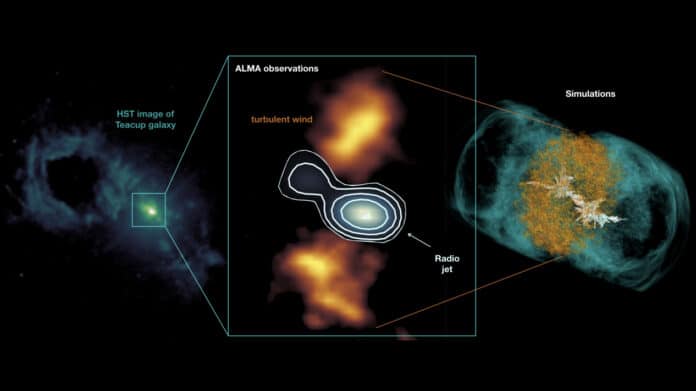To investigate the impact of radio jets on the interstellar medium (ISM) of galaxies hosting active galactic nuclei (AGN), an international scientific team led by the Instituto de Astrofísica de Canarias (IAC) researcher Anelise Audibert, discovered an ideal case: the Teacup galaxy. They studied the interaction of the radio jet with the cold gas around a massive quasar.
The Teacup is a 1.3 billion light-years away radio-quiet quasar, so named because one of the expanding bubbles visible in optical and radio photos resembles the handle of a teacup. Moreover, a compact, youthful radio jet with a slight inclination towards the galactic disc is present in the core area of the galaxy, which is around 3,300 light-years in size.
To characterize the cold, dense gas in the central part of the Teacup, the team used observations from Atacama Large Millimeter/submillimeter Array (ALMA). They specifically identified the emission of carbon monoxide molecules that can only exist under certain conditions of density and temperature.
The observations also showed the compact jet, despite its low power, is disrupting the distribution of the gas and heating it, and accelerating it unusually.
When the team reviewed the results, they discovered that the cold gas was more turbulent and warmer in the directions perpendicular to the jet propagation, contrary to what they had anticipated would be seen in the impacted regions along the jet.
The IAC researcher Anelise Audibert said, “This is caused by the shocks induced by the jet-driven bubble, which heats up and blows the gas in its lateral expansion. Supported by the comparison with computer simulations, we believe that the orientation between the cold gas disk and the jet is a crucial factor in efficiently driving these lateral winds.”
Cristina Ramos Almeida, an IAC researcher and co-author of the study, said, “It was previously believed that low-power jets had a negligible impact on the galaxy, but works like ours show that, even in the case of radio-quiet galaxies, jets can redistribute and disrupt the surrounding gas, and this will have an impact on the galaxy’s ability to form new stars.”
Journal Reference:
- A. Audibert et al., Jet-induced molecular gas excitation and turbulence in the Teacup, Astronomy & Astrophysics (2023). DOI: 10.1051/0004-6361/202345964
